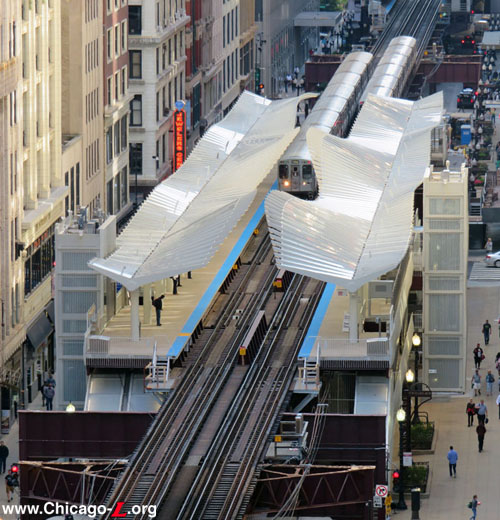
An aerial view of the Washington/Wabash station, looking south on September 5, 2017 as a Brown Line train enters the station, shows off the facility's signature design element -- modern, visually-dynamic canopies over the dual side elevated platforms whose structure forms undulating waves. For a larger view, click here. (Photo by Graham Garfield) |
Washington/Wabash
(100N/46E)
Washington Street and Wabash Avenue, Loop
Service
Notes:

|
Green Line:
Lake-Ashland-East 63rd |

|
Brown Line:
Ravenswood |

|
Orange Line:
Midway |

|
Purple Line:
Evanston Express |

|
Pink Line:
54/Cermak-Loop |

|
Accessible
Station |

|
Transfer to
NICTD: South Shore Line |
|
Transfer to
Metra: Electric District |
Quick Facts:
Address: 29 N. Wabash Avenue
Established: August 31, 2017
Original Line: n/a
Previous Names: none
Skip-Stop Type: n/a
Rebuilt: n/a
Status: In Use
History:
Washington/Wabash is a station on the Wabash leg of the Loop Elevated in Downtown Chicago. The station replaced and consolidated the Randolph/Wabash and Madison/Wabash stations into one facility, located between the two former stations.
The construction of a new Washington/Wabash station
mirrors work completed on the Wells side of the Loop in the
mid-1990s. There, stations at Randolph and Madison were also demolished and
replaced with an intermediate stop at Washington.
This reduced the number of stations on the west leg of the Loop from
three to two, the same number as on the north (Lake) and south (Van
Buren) legs of the Loop Elevated (the latter achieving two stops
after the opening of Library station in
1997). Replacing the Randolph and Madison stations on the Wabash side put two stations uniformly on all
four sides of the Loop.
Accessibility at the new Washington/Wabash station is
provided by both elevators and escalators. There are also
stairways to both side platforms. The new facility is large enough to accommodate customer
traffic from both Randolph/Wabash and Madison/Wabash.
The new Washington/Wabash station, like its
Wells Street cousin, is not over Washington itself but
between Washington and Madison, with the south portion of the station
platforms continuing over Madison Street. This is not only for station spacing purposes but also for the
staging of the construction, in which the first phase required closing
and demolishing the Madison/Wabash station to allow construction of the new facility to begin. The Randolph/Wabash station remained open until the new station was completed.
Plans for
Consolidation
The Randolph/Wabash and Madison/Wabash stations have been targets for demolition and consolidation for several decades. As early as November 1981, CTA planned to demolish them and construct a new facility at
Washington/Wabash. In January 1983, the "Loop Station Renovation
Project (Wabash)" included retrofitting the Adams/Wabash station (with construction proposed for the latter part of 1983) and
the construction of the Washington/Wabash station in 1985, with
Randolph proposed to be demolished in June of that year. This general plan has been regularly
More recently, a plan proposed by the CTA in 1998 had the new station placed between Randolph and Washington.
In this version, projected to cost $29 million, the new station was to have entrances on Randolph, Wabash and Washington. On
September 11, 1998, the CTA announced that they planned to permanently close the State/Lake and Madison/Wabash elevated
stations and replace the Randolph/Wabash facility with a "super
station." Supposedly combining function, aesthetics and the need to
replace "L" structures that date to the 1890s, the new station would
have become the third-busiest station in the
CTA's system and would've included a pedway connection to the Red Line
subway one block away. The design of the new station, which was
undergoing final review by officials from the city, the
CTA and the
Greater State Street Council, was described as a traditional, but
modernized version of the Madison/Wabash station. As part of the construction work, the entire elevated
structure was to be rebuilt from Lake to Washington streets and the
support columns down the middle of Wabash would've been replaced by columns
anchored along the curbs.
The consolidation plan languished for several years after, but did
not disappear entirely. The designs from the late-1990s were
apparently shelved, as the plan to consolidate three stations -- State/Lake, Randolph/Wabash and Madison/Wabash -- was revised in
favor of only consolidating the latter two, leaving State/Lake to be replaced with a new station facility east of State Street. An
intergovernmental agreement was approved at the April 3, 2003
CTA Board
meeting, providing $1 million to the Chicago Department of Transportation
(CDOT) for preliminary design and engineering work for the
construction of a new station at Washington/Wabash. The
CTA was to work
with CDOT to design the station.
A New Station Takes Shape
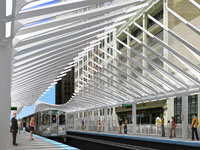
An artist's conception of the Washington/Wabash platform shows what the station is envisioned to look like at platform level looking north. The angled canopy weaves along the length of the platform like angled ribs on a spine. For a larger view, click here. (Rendering courtesy of CDOT) |
By Autumn 2011, the Washington/Wabash project was estimated to cost is $80.5 million, and officials hoped to have the money lined up to begin construction in 2014 or 2015, according to CDOT spokesman Brian Steele.1 Preliminary designs in place at that time called for stairs and an elevator at Washington Street on the west side of Wabash, and stairs and an escalator on the east side. Midway between Washington and Madison, two stairwells would serve exiting passengers. Two auxiliary entrances would be located on each side of Wabash just south of Madison to serve former users of the Madison/Wabash station. The new station would have larger platforms, increasing from 7-1/2 feet wide in some places currently to up to 16 feet.2 The fare controls, stairs, escalators, elevators, electrical, security and communications rooms would be on the mezzanine level.3 As of Autumn 2011, only funding for design and engineering had been secured. About $75 million was still needed for construction.4
At the dedication of the renovated Grand Red Line subway station on January 17, 2012, Chicago Mayor Emanuel announced the City's intention to proceed with several "L" station projects, including the new Loop station at Washington/Wabash, as well as construction of a new Green Line station at Cermak and the rehabilitation of the Clark/Division subway station. Final design work was scheduled to begin in May 2012, with construction scheduled to begin in April 2013 and expected to be complete by September 2014.5
Work, however, was delayed due to additional environmental studies that were required for the Loop project that were not initially anticipated, according to CDOT. The project was still in the design phase during Spring 2013, and CDOT anticipated soliciting construction bids by the end of 2013. Construction was projected to begin in mid-2014, with opening of the new station expected in late 2015.6
As design work on the new station was reaching the final stages, the final renderings for the planned Washington/Wabash station were released by the mayor, CDOT, and CTA on September 30, 2013.7
The $75 million station was funded entirely by Congestion Mitigation and Air Quality (CMAQ) funds. The Chicago Department of Transportation managed the design and construction of the station. In Fall 2013, the CTA estimated the station would have 13,375 daily entries (annual weekday average), making it the 5th busiest "L" station on weekdays. The annual total for the station is estimated to be 4.02 million rides.8
Station Design
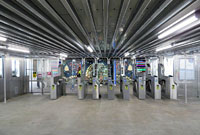
The fare controls at the Madison end of the Washington/Wabash mezzanine are seen looking north from the unpaid area on August 31, 2017. The uncluttered floorplan and open, light grilles on the fencing attempts to compensate for the low ceilings and keep the space as spacious as possible. For a larger view, click here. (Photo by Graham Garfield) |
Design services for the station were carried out by exp (started while they were under their former name, Teng + Associates), an integrated architecture and engineering firm recognized for design excellence in architecture and engineering for an array of projects in both the public and private realm.9
The Washington/Wabash station was designed to be "showcase" station with impressive aesthetics and presence -- the City intended the design to "transform the public's perception and expectation of public transportation in Chicago" -- and serve as a gateway for Millennium Park and the Loop.10
The station is located between Washington and Madison streets -- similar to the citing of Washington/Wells on the west leg of the Loop -- with the station starting just south of Washington Street and extending south over Madison Street.
The station's signature design element is the canopy over the dual side elevated platforms, a modern design with undulating waves serving as a contrast to the city grid according to the City: the "form of the canopies weaves through the historic Wabash Avenue corridor as a counterpoint to the city grid, and anticipates the soft forms of the park and the lake beyond. The faceted skeletal steel and glass structure is designed to create a dynamic play of light reminiscent of diamond facets and the historic Jeweler's Row."11
The Chicago Tribune's architecture critic Blair Kamin called Washington/Wabash "a clean-lined, visually dynamic transit station whose platform level feels remarkably open. The cityscape benefits because the light and airy modernist design," whose canopy Kamin said "seems to copy the work of the global architect and engineer Santiago Calatrava, whose best known completed work in the Midwest is his striking, bird-like addition to the Milwaukee Art Museum." Kamin went on to say,
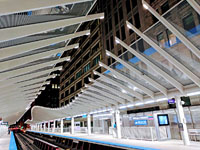
The spines of the canopies' distinctive skeletal structure, seen early the morning of August 31, 2017 shortly after the station opened, vary in length and angle to create the illusion that the canopy curves. LEDs at the tips of the spines accentuate the curvature and reference the diamonds of Jeweler's Row, where the station resides. For a larger view, click here. (Photo by Tony Coppoletta) |
"[the canopies] do more than simply protect riders from the rain and snow. Their distinctive skeletal structure consists of ellipse-shaped steel columns that support a spinelike element running parallel to the edge of the platforms. Angled steel ribs spring upward from the spine and support glass panes that cover the platforms. None of the elements curves, but their varied lengths and angles create the illusion that the canopy curves both from top to bottom and from side to side. Architects and artists call this sort of thing trompe l'oeil, which literally means 'fool the eye.' LEDs at the tips of the ribs accentuate the curvature.
"The upward tilt of the canopies creates a welcome sense of airiness, while their glass ceilings admit daylight and open views of the sky and surrounding buildings. Throughout, functional elements like gutters, electrical wiring and speakers are carefully tucked into the structure rather than clumsily applied.
"Great care was put into the laser-cut pickets that serves as guardrails for the station's platforms, mezzanine and stairs; their curving profile echoes the canopies' undulating motif. In a nice riff, the pickets that sheathe the station's elevator towers are cut so they portray the CTA's circular logo when seen at an oblique angle."12
The station has two sets of entrances, at Washington Street and approximately 100 feet north of Madison Street. At the corner of Washington and Wabash, an entrance stairway is located on the southwest corner, and a second stairway along with an escalator are on the southeast corner. Entrance stairs are also located on both sides of Wabash north of Madison. In addition, there are elevator towers on both sides of Wabash, mid-block between Washington and Madison -- the tower on the west side about halfway between the Washington and Madison stairways, and on the east side a short distance south of the stair and escalator -- providing access from the street to the mezzanine, as well as from the mezzanine to the platforms.
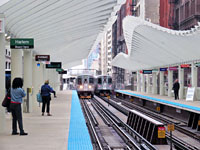
Tribune architecture critic noted, "The upward tilt of the canopies creates a welcome sense of airiness, while their glass ceilings admit daylight and open views of the sky and surrounding buildings... functional elements like gutters, electrical wiring and speakers are carefully tucked into the structure" -- looking south on August 31, 2017. For a larger view, click here. (Photo by Graham Garfield) |
All entrances lead to one block-long mezzanine. The mezzanine features unpaid areas at each end, each staffed and complete with customer assistant kiosks and fare vending machines, which feed a central paid area. Stairs and elevators in this central paid area lead to the dual boarding platforms. Electrical, security and communications rooms are also on the mezzanine level.
The platforms are accessed by a dual set of stairs on each of the east and west sides of the mezzanine, as well as the dual elevator towers. Each platform is 430 feet long, with the canopies covering the northern 400 feet of each platform. The north half of each platform is 13' wide, while the south halves are 10' wide, both considerably wider than the 7'-6" wide platforms of the Randolph and Madison stations they replace. The south ends of both platforms have an auxiliary exit down to the south side of Madison Street, with access controlled by an exit rotogate on each side at platform level. Materials on the platforms were chosen to allow visibility, reinforce the feeling of openness and to allow a visual connection to the historical corridor.13
The station features a wide array of green and sustainable elements, including: 100 percent LED lighting; reuse of a significant amount of existing structure and tracks; bicycle racks to encourage alternative transportation; recycling bins on the platforms to encourage paper recycling; Concrete Masonry Units (CMUs, or "cinderblocks") used in wall assemblies from regional sources; structural steel comprised of recycled material; metal fabrications used for cladding, wall infill panels, windbreaks, handrails and other items comprised of recycled content; rough carpentry required for blocking comprised of Certified wood; sealants and adhesives, exterior paint for the structural steel and interior paint for CTA offices with a low-VOC content to improve air quality; and HVAC systems used for the Customer Assistant and Concessions kiosks using CFC-free refrigerant.14
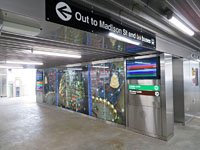
Art glass installations titled Cosmic Wanderlust 1 & 2 face passengers after they pass through the turnstiles at either end of the mezzanine, framed by backlit directional signage and digital train arrival screens, seen on August 31, 2017. For a larger view, click here. (Photo by Graham Garfield) |
The Washington/Wabash station also features several public art installations created especially for the station, located in the mezzanine level. Chicago-based artist Michiko Itatani created two large art glass panels -- Cosmic Wanderlust 1 & 2 -- located on the walls facing passengers after they pass through the turnstiles on either side of the mezzanine; these reflect on human history and culture of the past, present and future. The artist's multi-colored perspective of this theme features images of libraries, museums, public spaces and performance halls intermingled with images of the cosmos. In addition, the walls along the sides of the mezzanine on the paid side, facing the sets of the stairs up to the platforms, feature mural-like glass walls that depict pedestrians. Formed out of groupings of circles containing the full name and first letter of various "L" station names, reminiscent of CTA station symbol signs, the figures are, in fact, modeled on the members of exp's design team.
The Washington/Wabash station design was awarded the 2018 Distinguished Building Award - Honor Award by the Chicago chapter of the American Institute of Architect. AIA said the architecture of the station canopies is appealing because it is "simple, elegant and economical."
"Architecture firm EXP reimagined the concept of the busy station, creating an elegant canyon that stretches down the city’s historic Wabash Avenue," a statementfrom AIA said. "Wave-like canopies are juxtaposed against the angular backdrop, elevating the station from a functional checkpoint to public sculpture."
"The skeletal steel and faceted glass structure create a dynamic play of light alluding to diamond facets and the immediate Jeweler’s Row context," AIA explained. "From the platform, the canopy serves as a deliberate contrasting frame that captures views to the historic Wabash facades."
Station Construction
In early January 2015, the city awarded Chicago construction company F.H. Paschen, S.N. Nielsen a $74.8 million contract to build the new Washington/Wabash station.15
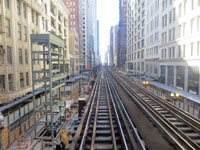
The station's Outer Loop platform (east) elevator tower structure is in place in this March 17, 2016 view looking south. Other platform steel has yet to be erected. For a larger view, click here. (Photo by Graham Garfield) |
Construction of the station began in March 2015. The project required the full closure of Wabash between Washington and Madison during the first stages of construction, beginning Monday, March 9, 2015. The Madison/Wabash station closed on March 16, 2015, to accommodate construction of the new station, with demolition to begin soon after.
Construction of the new Washington/Wabash station continued into 2016, with the first elements of the station facility itself beginning to take shape. The majority of the work up to late spring and summer 2016 was critical but less visible -- utility relocations, modifying or filling in vaulted sidewalks, foundation excavation and erection. There were also a number of minor modifications that had to be made to the existing elevated track structure to accommodate the new station structures.
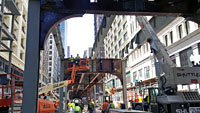
All of the old, large steel stringers have been removed and the new upturned girders are in place during a weekend closure on June 18, 2016. Transferring the structural load above track level will provided the additional clearance for the mezzanine to be added. For a larger view, click here. (Photo courtesy of CTA) |
The first very visible element was added when the steel structure of the east elevator tower was lifted into place the morning of Sunday, February 8, 2016. It was joined by the west elevator tower on Sunday, August 14. In between, a number of more elaborate modifications had to be made to the existing 1895-built elevated structure to accommodate the new station it would support. The most substantial of these was replacing all of the large steel stringers, which run parallel to and below the tracks, with upturned girder spans in two sections. This allowed the structural load to be carried above track level and increased the clearance between the tracks. In these two sections, the new fare control mezzanine will span the width of the tracks, and there would have been insufficient clearance between the mezzanine floor and the street if the original spans were kept. The upturned girder spans for the north mezzanine were installed at bents 321-322 over the weekend of June 17-20, and for the south mezzanine at bents 323-324 over June 24-27. Over these weekends, the Lake and Wabash sides of the Loop were closed and all trains were diverted via the Wells and Van Buren sides. Trains were similar rerouted over several other weekends when work needed to take place to modify the track structure or that would have interfered with train operation.
In late summer and fall 2016, steel stringers and joists for the platforms began to be installed, with the new platform structure quickly taking shape.
Wabash Street between Madison and Monroe streets re-opened on Wednesday, November 23, 2016 in the Loop. The street re-opened about 11:15 a.m. as construction continues on a new CTA elevated train station at Wabash and Washington streets; Wabash will remain closed between Washington and Madison until early 2017, CDOT said.
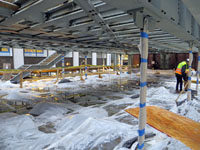
The north half of the station mezzanine has its concrete floor in place, and covered with plastic to protect it from the winter precipitation, looking southeast on January 17, 2017. For a larger view, click here. (Photo by Graham Garfield) |
By late December 2016, platform stringers and joists were in place for most of both platforms' lengths, from their north ends near Washington Street almost to Madison Street, with just portions just a bit north of and over Madison remaining to be installed. The steel for the mezzanine level was also in place, with rebar installed in the floor ready for the concrete deck to be poured. Nearly all of the stairways, between the street and mezzanine and between the mezzanine and platforms, were also installed by the end of 2016.
Platform steel continued to be installed during winter, and into spring 2017. Structural steel for the platform canopies began to be installed in late January, beginning with support columns. The canopy's characteristic "spines" began to go up in February.
By late January, the north half of the mezzanine had its poured-in-place concrete floor, and the south portion of the slab was being prepped to be poured.
Erection of canopy columns and spines, and installation and detailing of platform precast platform decking continued through February and March, and into April. Some of this work required the east leg of the Loop to be temporarily closed from 2 a.m. Saturday, March 18 until 4 a.m. Monday, March 20. During that period, Orange and Brown Line trains operated as one route between Kimball and Midway, via Wells and Van Buren; Green Line trains operated between Harlem and 63rd via Wells and Van Buren; and Pink Line trains operated between 54th/Cermak and Polk, then to Racine station on the Blue Line for connecting Blue Line train service to/from downtown.
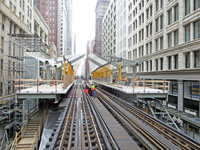
Construction of the new Washington/Wabash station is proceeding apace, with the platform deck panels in place and the spine-like structure of the distinctive undulating canopy taking shape at the northern two-thirds of the station. This view looks south on March 28, 2017. For a larger view, click here. (Photo by Graham Garfield) |
By late March, in addition to ongoing platform and canopy work, crews were installing elevator cladding, visual barriers and windscreens.
The section of Wabash Avenue between Washington and Madison reopened on Friday, March 31, 2017, a move CDOT called a "milestone" in the construction of the new elevated station. The closure between Madison and Washington started in November 2016, following a 10-week closure of Wabash between Madison and Monroe.
Through May and into early June, work continued on canopy welding and detailing, and cladding of the elevator towers.
During another weekend closure, over June 17-19, 2017, workers erected additional canopy sections over the tracks, installed canopy glazing and platform fixtures, and painted the canopy and structure.
The last section of canopy structure was installed on Saturday, July 8. Work continued into July on installing the canopy roof glazing, typically overnight during the few hours when no train service was scheduled to run. During the day, contractors worked on welding and detailing the canopy steel and precast platform panels, installing canopy and elevator tower glazing, and installing platform railings. Work was also underway on wiring lighting, PA speakers, and other systems.
The extensive scaffolding along the sidewalks on both sides of Wabash Avenue came down at the end of July, CDOT officials announced Monday morning, July 31, providing unobstructed sidewalks along Wabash between Monroe and Washington streets. An additional two weekend closures on Madison Street at Wabash were required in August before the new station opened.16
The Washington/Wabash station opened at 4am, Thursday, August 31, 2017. The station was dedicated at a press event at around 11am that morning, officiated by Mayor Rahm Emanuel, CTA President Dorval R. Carter, Jr., CDOT Commissioner Rebekah Scheinfeld, and US. Congressman Danny Davis (D-IL), who is often credited with securing the federal CMAQ funding for the project.
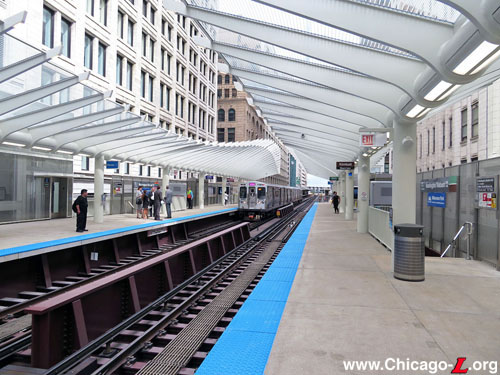
Washington/Wabash station's signature design element is the canopy over the dual side elevated platforms, a modern design with undulating waves serving as a contrast to the city grid according to the city. The platforms and canopies are seen looking north as a Pink Line train enters the station on opening day, August 31, 2017. For a larger view, click here. (Photo by Graham Garfield) |

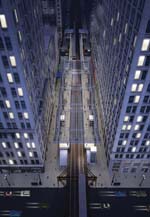 |
washington-wabash-rendering01.jpg (189k)
This artist's rendering of the proposed Washington/Wabash station provides an aerial view of the facility, and shows its relationship to the Wabash Avenue streetscape and how the facility will be laid out. The station will stretch from the south side of Washington to south of Madison. The main entrances will be on the southeast and southwest corners of Washington and Wabash, with the elevator on the southwest corner. The main canopy, which will be full-width and feature an undulating "wave" profile, will stretch nearly the entire block from Washington to Madison. Where the platforms span over Madison, there will be no canopy, to provide a less restricted view from the west of Millennium Park to the east. A short canopy will resume over each platform south of Madison, covering each platform and a set of auxiliary stairs on Wabash south of Madison. (Rendering courtesy of CDOT) |
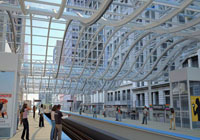 |
washington-wabash-rendering02.jpg (??k)
An earlier artist's conception of the Washington/Wabash platform shows what the station was envisioned to look like at an earlier design stage at platform level looking south. Though the undulating glass and steel canopy differs here from the final design, the element was a signature part of the station's design even at earlier design stages. (Rendering courtesy of CDOT) |
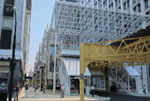 |
washington-wabash-rendering03.jpg (208k)
This artist's rendering of the proposed Washington/Wabash station depicts the facility at an earlier design stage as seen looking south from the corner of Washington and Wabash Stairs on each corner lead to a mezzanine, with the elevator located on the southwest corner. The undulating canopy profile was included both for aesthetics as well as to discourage pigeons from roosting on the canopy structure. (Rendering courtesy of CDOT) |
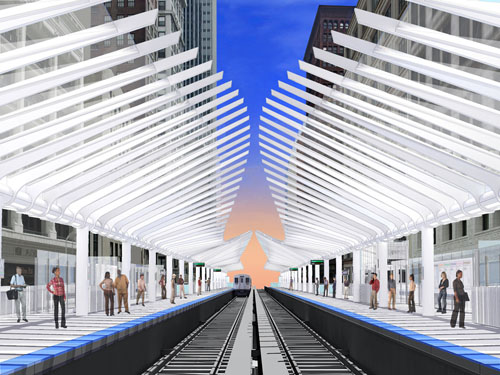 |
washington-wabash-rendering04.jpg (??k)
An artist's conception of the Washington/Wabash platform shows what the station is envisioned to look like at platform level looking south. The undulating skeletal steel and glass canopy is a signature part of the station's design. (Rendering courtesy of CDOT) |
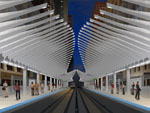 |
washington-wabash-rendering05.jpg (216k)
The same view at the top of the page, looking south down the platform of the Washington/Wabash station, is seen at night, demonstrating how the platforms will be illuminated, including lights at the tips of the canopy "spines". (Rendering courtesy of CDOT) |
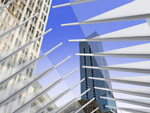 |
washington-wabash-rendering06.jpg (194k)
An artist's rendering shows a detail view of the apex of the platform canopies over the tracks, where the two angled side platform canopies nearly come together. This view shows how the translucent canopy roofing ends before the edge of the roof supports, with have lights embedded along their tips. (Rendering courtesy of CDOT) |
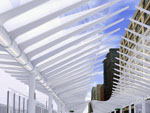 |
washington-wabash-rendering08.jpg (195k)
The view in this artist's rendering focuses on the platform canopies' structure, supports, and design, exhibiting how the faceted skeletal steel and glass structure is designed to create a dynamic play of light. (Rendering courtesy of CDOT) |
 |
washington-wabash-rendering09.jpg (379k)
This conceptual image of the Washington/Wabash station is the same view as the earlier rendering above, showing how the design of the station evolved by providing a comparison with the same view at a later stage of design. The basic layout remains the same -- the station stretches from just south of Washington (at the bottom) to across Madison (at the top), with entrances near Washington and mid-block leading to a central mezzanine -- but the biggest difference is the revised canopy design, which still had an undulating "wave" profile but a very different design and aesthetic relationship with the Wabash streetwall. (Rendering courtesy of CDOT) |
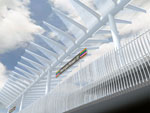 |
washington-wabash-rendering10.jpg (163k)
An artist's rendering shows how the platform canopy and railings appearing looking up from a street-level vantage point. The "skeletal" motif of the canopies is carried through the railing design as well. (Rendering courtesy of CDOT) |
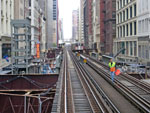 |
washington-wabash02.jpg (286k)
A Purple Line Express train is passing through the station construction zone, as the flagmen protecting the workers returns to his position on the catwalk to watch for and signal the next train, looking south on June 16, 2016. The new up-turned girders that will support the track structure while giving more headroom clearance for the mezzanine are in place, but they're not actually supporting anything yet; the original track stringers are still in place and carrying the load. The switch-over would occur a few days later. (Photo by Graham Garfield) |
 |
washington-wabash03.jpg (210k)
A shower of sparks accompanies the workers cutting the connections holding the original track stringers to the bents, as they are prepared to be removed, looking east just after 7am on June 18, 2016. The spans are being replaced with the up-turned gray girders, already in place, to create additional height clearance under the tracks. (Photo courtesy of CTA) |
 |
washington-wabash04.jpg (213k)
After having its connections to the bents on either side cut, a track stringer is being lowered down to the ground to be removed, around 7:45am on June 18, 2016. Once the stringers are all removed, crossbeams will be installed between the new, gray up-turned girder to support the tracks, which will then be installed -- all in time for service to resume at 4am Monday, less than two days later. (Photo courtesy of CTA) |
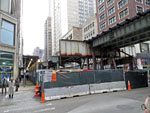 |
washington-wabash06.jpg (213k)
Looking north at Wabash and Madison on January 17, 2017, the columns on both ends of the elevated structure bent have been removed, with the stringers intermediately held up by temporary supports. The columns will be replaced with new vertical supports, which will better support the load of the new platforms. (Photo by Graham Garfield) |
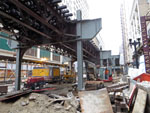 |
washington-wabash07.jpg (258k)
A view looking north up Wabash Avenue from Madison Street on January 17, 2017 shows a series of elevated structure bents whose crossbeams are still the original 1896 steel, connected to the original 1896 stringers (identifiable as the maroon-painted members), but whose columns have all been replaced, with new steel extending outward from the columns (the gray steel) to support the steel for the new station platforms. (Photo by Graham Garfield) |
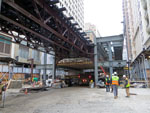 |
washington-wabash08.jpg (268k)
The new steel structure for Washington/Wabash's wide platforms and mezzanine is in place, surrounding the more delicate-appearing 19th century steel elevated track structure, in tis view looking north mid-block between Madison and Washington streets on January 17, 2017. (Photo by Graham Garfield) |
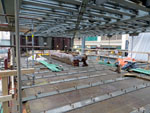 |
washington-wabash09.jpg (243k)
The basic structure of the south half of the Washington/Wabash mezzanine is in place in this January 17, 2017 view looking south. The steelwork above supports the tracks immediately overhead, spanning between the up-turned girders installed to provide the headroom to accommodate the addition of the mezzanine. The steel structure and base slab for the bottom deck are in place; soon, a top layer of concrete will be poured in place for the floor. (Photo by Graham Garfield) |
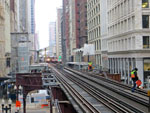 |
washington-wabash11.jpg (279k)
The platform canopies are beginning to take shape at Washington/Wabash, as seen looking south on February 28, 2017. Several canopy columns are in place, and work is beginning to install the "spines" for the undulating covering. Precast concrete deck panels have begun to be installed. Both elevator towers are in, and scaffolding surrounds the east (Outer Loop) tower as work proceeds on installing cladding on the tower. (Photo by Graham Garfield) |
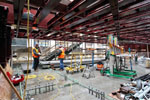 |
washington-wabash13.jpg (271k)
The long mezzanine of the new Washington/Wabash station is advancing, with the concrete floor structure poured in place in this March 30, 2017 view looking southeast in the north half of the mezzanine. The electrical and communications stub-ups for things like fare equipment and other apparatus visible in the floor. One of several stairs to the platform is visible in the background. (Photo courtesy of the City of Chicago) |
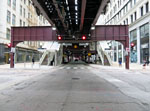 |
washington-wabash15.jpg (217k)
The stairways on either side of Wabash Avenue, on the south side of Washington Street, are seen looking south on August 31, 2017. The east stair is paired with an escalator (the only one in the station, and only from street to mezzanine); elevators are tucked behind the stairways on both sides. (Photo by Graham Garfield) |
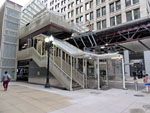 |
washington-wabash16.jpg (229k)
The stair and escalator combo on the southeast corner of Wabash and Washington carry passengers to the north end of the station's mezzanine; the elevator behind it provides an ADA-accessible pathway to the same, with the doors facing the street. The Outer Loop platform and station's distinctive canopy are visible overhead on August 31, 2017. (Photo by Graham Garfield) |
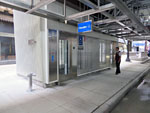 |
washington-wabash17.jpg (178k)
The street-level entry to the east elevator is seen looking south on August 31, 2017. Another identical elevator is located on the west side of the street as well, a little farther south. With the elevator doors facing the street, they are a little hidden from view approaching on the sidewalks. (Photo by Graham Garfield) |
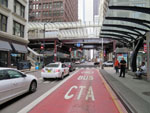 |
washington-wabash18.jpg (235k)
The south end of the Washington/Wabash station is seen looking west from the Madison/Wabash Loop Link station on August 31, 2017. The new "L" station and the Loop Link bus transitway were both constructed around the same time, both by the Chicago Department of Transportation (CDOT). Both employ distinctive, though different, modern architecture. (Photo by Graham Garfield) |
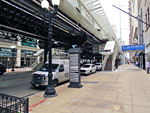 |
washington-wabash19.jpg (251k)
The stairways on either side of Wabash Avenue, just north of Madison Street, are seen looking north on August 31, 2017. The surrounding retailers illustrate the street's Jeweler's Row monicker. (Photo by Graham Garfield) |
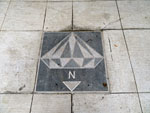 |
washington-wabash20.jpg (261k)
The compass roses at the foot of each stair at street level, to orient passengers as they leave the station, include a diamond motif in reference to the station's Jeweler's Row location. One is seen on August 31, 2017. (Photo by Graham Garfield) |
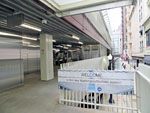 |
washington-wabash21.jpg (166k)
The southeast (seen here, looking north on August 31, 2017) and southwest corners of the station mezzanine feature short passages connecting the stairways from the street to the fare control area; the stairways at the north end lead more directly into the mezzanine. A banner commemorating the opening of the station hangs on the laser-cut railing pickets whose curving profile echoes the platform canopies' undulating motif. (Photo by Graham Garfield) |
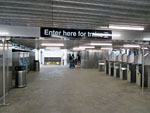 |
washington-wabash22.jpg (224k)
The fare control area at the south end of the station mezzanine, near Madison Street, is seen looking west on opening day, August 31, 2017. The fare vending machines are on the left; the turnstiles, leading to the boarding platforms, are on the right. The station agent's booth and elevator to the street are in the background. (Photo by Graham Garfield) |
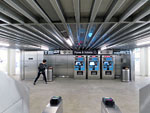 |
washington-wabash24.jpg (197k)
Both mezzanine fare control areas feature a recessed alcove to house the fare vending machines, as well as other vending machines and ATMs, to keep the space organized and open. The soffit over the alcove integrates signage, speakers and security cameras for added integration and aesthetic streamlining. The recess in the south fare control area is seen looking south from through the turnstiles on August 31, 2017. (Photo by Graham Garfield) |
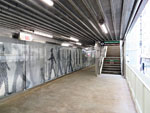 |
washington-wabash26.jpg (234k)
A view of the east side of the Washington/Wabash station mezzanine's middle paid area, looking north on August 31, 2017, shows a stair up to the Outer Loop platform used by Brown and Harlem-bound Green Line trains -- another identical stair is behind the camera -- and artwork along the enclosed center area of the mezzanine featuring silhouetted figures of commuters. (Photo by Graham Garfield) |
 |
washington-wabash27.jpg (306k)
The silhouetted figures that make up the artwork along the inside walls of the center area of the mezzanine are formed by circles that each contain the name of an "L" station and the first letter of that station name in large type, a reference to the CTA's station symbol signs at "L" stations. The figures themselves are actually members of the exp staff that worked on the station design project. (Photo by Graham Garfield) |
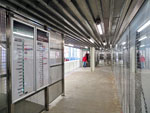 |
washington-wabash28.jpg (237k)
Looking south at the same area seen above, the east side of the Washington/Wabash station mezzanine is seen on August 31, 2017. Each platform stairway features a set of directional line diagrams to help passengers navigate to the correct platform for their journey, with a set on either side of the stairs so they are visible whether the rider approaches from the north or the south fare controls. (Photo by Graham Garfield) |
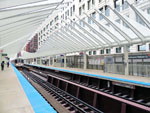 |
washington-wabash31.jpg (280k)
The undulating waves of the Washington/Wabash station's signature canopies serve as a contrast to the city grid
and the historic buildings around the station. Angled steel ribs spring upward from the spine and support glass panes that cover the platforms. , However, none of the elements curves -- their varied lengths and angles create the illusion that the canopy curves both from top to bottom and from side to side.
A Brown Line train enters the station on August 31, 2017, looking south at the north end of the platforms where passengers center and more amenities like heaters and map/timetable panels are located. (Photo by Graham Garfield) |
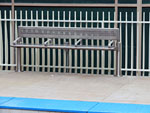 |
washington-wabash32.jpg (186k)
The benches along the Washington/Wabash platforms have a modern that matches the station's aesthetic, one of which is seen on August 31, 2017. (Photo by Graham Garfield) |
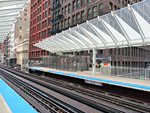 |
washington-wabash33.jpg (298k)
The south ends of the Washington/Wabash platforms feature auxiliary exits down to the south side of Madison Street, wach featuring two rotogates to control access and emergency crashbar doors for evacuation capacity. The auxiliary exit from the Inner Loop platform is seen looking southwest on August 31, 2017. (Photo by Graham Garfield) |
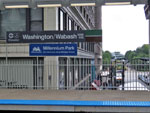 |
washington-wabash35.jpg (210k)
The Washington/Wabash station serves Millennium Park, located a block away. The park, an elaborately-designed and landscaped public space featuring several attractions designed by famous architects that had become the number one tourist attraction in the Midwestern United States by 2017, is identified by landmark signs under some of the station name signs on the platfrorm. The Jay Pritzker Pavilion bandshell is seen in the background beyond the platform railing, on August 31, 2017. (Photo by Graham Garfield) |
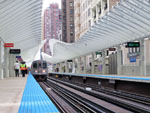 |
washington-wabash36.jpg (264k)
The curving waves of the Washington/Wabash platform canopies are accentuated in this view looking north as a Midway-bound Orange Line train enters the station on opening day, August 31, 2017. (Photo by Graham Garfield) |
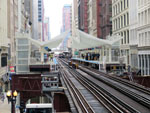 |
washington-wabash37.jpg (276k)
An end profile view of the Washington/Wabash station, looking south from the adjacent Randolph/Wabash station (which closed a few days later) on August, 31, 2017, shows the shape of the station's trademark canopies, in section at the ends and then demonstrating its undulating shape when viewing the forced perspective of its length. The positioning of the staggered elevator towers on each side is also evident. (Photo by Graham Garfield) |
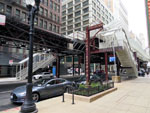 |
washington-wabash38.jpg (263k)
The auxiliary exit stairs from each Washington/Wabash platform down to Madison Street are seen looking north on August 31, 2017. The stair from the Inner Loop platform down to the southwest corner of Wabash and Madison descends straight down, while the stair from the Outer Loop to the southeast corner has a switchback and lands passengers on the actual street corner. (Photo by Graham Garfield) |
 |
washington-wabash39.jpg (218k)
The auxiliary exit stair from the Washington/Wabash Inner Loop platform, down to the west side of Wabash Avenue just south of Madison Street, seen looking north on August 31, 2017. Ample signage over the stairs and on the risers warns customers on the street that they cannot enter there, while a compass rose in the sidewalk helps orient customers exiting from the platform. (Photo by Graham Garfield) |
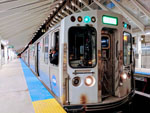 |
washington-wabash40.jpg (254k)
The very first train to call at Washington/Wabash in revenue service -- Harlem-bound Green Line Run 602 -- is seen making its historic station stop just after 4:15am on August 31, 2017. (Photo by Tony Coppoletta) |
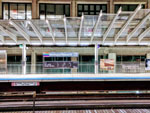 |
washington-wabash41.jpg (305k)
The illumination design of the Washington/Wabash station platforms is demonstrated on opening morning, in the early hours of August 31, 2017, looking west at the Inner Loop platform from the Outer Loop. The main platform lighting is integrated into the horizontal truck of the canopy structure, which doubles as a raceway for wiring, speakers, and gutter as well. LED lights at the tips of the faceted skeletal steel structure are designed to create a dynamic play of light reminiscent of diamond facets, referencing the historic Jeweler's Row district. (Photo by Tony Coppoletta) |
 |
washington-wabash43.jpg (199k)
Cutting the ribbon at the Washington/Wabash station on opening day, mid-morning on August 31, 2017, are (left to right) US. Congressman Danny Davis (D-IL 7th), Chicago Mayor Rahm Emanuel, CTA President Dorval R. Carter, Jr., and CDOT Commissioner Rebekah Scheinfeld. (CTA photo) |

|

|
Notes:
1. Hilkevitch, John. "Renovation in sight for Red Line eyesore". Chicago Tribune. September 26, 2011.
2. Ibid.
3."Mayor Emanuel Opens Newly-Renovated Grand Avenue Red Line Station." City of Chicago press release, January 17, 2012.
4.
Hilkevitch, ibid.
5. City of Chicago (2012), ibid.
6. Swartz, Tracy. "CDOT: Year delay on Loop superstation." Red Eye. April 23, 2013.
7
. "Mayor Emanuel Announces Release of Final Renderings of Washington-Wabash CTA Elevated Station" City of Chicago press release, September 30, 2013.
8. Ibid.
9. Ibid.
10. Ibid.
11. Ibid.
12. Kamin, Blair. "First new Loop 'L' station in 20 years creates curvy gateway to Millennium Park." Chicago Tribune, Cityscapes column, August 30, 2017.
13.
City of Chicago (2013), ibid.
14. Ibid.
15. Swartz, Tracy. "$75 million contract awarded for new Loop 'L' station." Red Eye. January 9, 2015.
16. Matthews, David. "Wabash Reopens In The Loop; New 'L' Stop To Open By Labor Day." DNAinfo Chicago, July 31, 2017.






















































